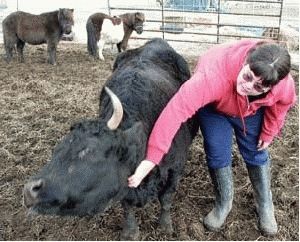MINI MOOS
Published 12:00 am Monday, February 28, 2005

- A little higher: And to the left, please, says Lord Milton, enjoying a good scratch from 14-year-old Danielle Lanxon.Miniature horses Crystal and her baby, Scratch, watch it all from a safe distance. (Story and photos by Mardi Ford).
Where can you find four head of cattle, two horses, a goat, a turkey, half a dozen chickens, two dogs and a cat thriving in peaceful coexistence with three humans on a one and a quarter acreage?
At the Mini Moo Farm in Cove the name holds a clue to the success of such a broad collection of farm animals on limited space. The cattle, as well as the horses and the goat, are all miniature breeds.
Though there are several places around Union County where miniature horses and goats may be found, the Dexter breed of cattle owned and tended by Steve and Diane Lanxon and daughter Danielle, is unusual. A fact these breeders hope to change.
"Dexters are so cool so much fun and so easy to take care of," says Diane, who grew up on a farm. "They’re known as the family cow."
If you’ve never heard of the Dexter, you aren’t alone. Though they are now becoming well-known across the U.S., they have been fiercely regarded for centuries by breeders in other
countries.
One of the smallest bovine breeds, Dexters originated in southern Ireland. It is thought to have originated as a cross between a Kerry and a Devon.
A full-grown Dexter bull typically weighs about 1,000 pounds while a mature cow daintily tips the scale at 750. Their bodies look longer and bulkier than one would expect to find in what is defined as a miniature breed. They are, however, much shorter in height than full size breeds.
"Well, there are long-legged Dexters and short-legged Dexters. You don’t want to breed two short-leggeds," Lanxon says, adding that Dexters are very strong for their smaller stature and often used as pulling draft pairs.
Lanxon says history indicates they were imported to the U.S. around 1905. Two hundred of them were recorded primarily to establish original herds in New York, Kentucky and Minnesota.
Today, Dexters are not only raised in the East, but have made their way West. Breeders from Oregon, California, Washington, Idaho, Colorado and Wyoming are currently registered with the American Dexter Cattle Association.
"But they’re really a big deal in the U.K., Australia, South Africa and Canada," Lanxon adds.
Dexters are known for their mild temperaments as well as the ability to thrive on less pasture and feed than other breeds, yet still producing more milk per weight than many other breeds. In addition, the average dress out rate for Dexter beef cow is very good at 50 to 60 percent. Dexter meat is reputed to be slightly darker, leaner and of excellent quality and flavor.
So, could Lanxon actually eat one of her darling Mini Moos?
"Absolutely!"
She is realistic about her breeding stock. "I put this money into them for a reason and if they don’t give me what I want, they have to serve another purpose."
She looks toward Molly, one of their two registered cows that has yet to calve. Half-sister, Lady Patty of Dublin, had her first calf Dec. 16 and Lanxon thinks she is already pregnant again. Patty and Molly live with Lord Milton, a bull the Lanxons bought after artificial insemination attempts proved fruitless.
Although Milton looks like a fierce bull with his broad face and curved horns, he is actually easygoing and non-aggressive. He holds a protective stance in front of "the girls" then decides it’s OK to wander over for some attention from the two-legged types. Milton’s favorite playmate, however, is Scratch, the youngest of the Lanxons’ two miniature horses. Sometimes their play gets little rough, as boys will be boys.
"One day, we were watching them and Milton lifted Scratch right up off the ground with his horns and kind of tossed him. Scratch hit the ground, didn’t move and we thought, ‘Oh, no he’s hurt this time.’ Milton kinda stood there for a minute looking at him, and started over. As soon as he put his nose down, Scratch jumped up and scampered off the little stinker was playing possum," Lanxon laughs.
The apple of her eye, however, is two-month old Chris Mini Moo’s Christmas Star the first-born Dexter baby out of Mini Moo Farm.
Chris currently enjoys star treatment enjoying the run of the backyard with Missy and River, the family dogs.
"He thinks he is a dog," Lanxon says, as she watches him scamper up on the deck and back down again with his canine cohorts. At 50 pounds, Chris is now roughly the size of Missy and River.
Lanxon hopes she already has him sold to a local family as a pet for the children. It would be a good place for Chris and a blessing for Lanxon, who has enjoyed mothering him.
"He weighed about 20 pounds when he was born. I used to pick him up in my arms, just like a baby," Lanxon says. And as a well-loved baby, Chris is secure in his place in the world, as he nudges his soft nose toward the bottle she holds. Seeking just the right angle, Chris bumps Lanxon with his nubby little horns and nibbles on the hem of her jacket until finally settling down for a satisfying meal.
His eyes half-closed in ecstasy his little black tongue finds its rhythm.






